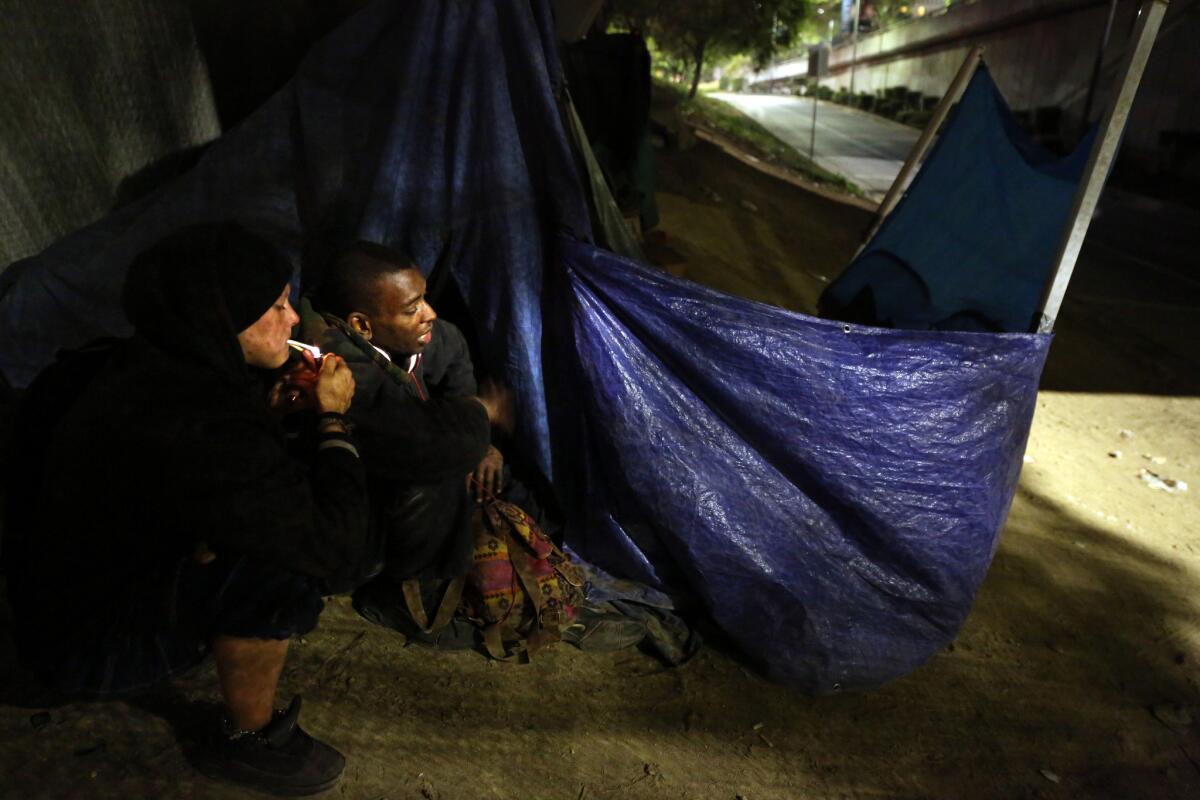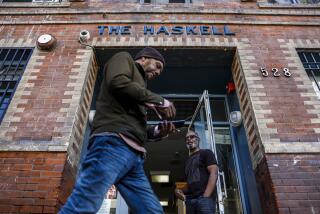Hidden homeless make do in the shadows of downtown L.A.’s luxury

Ammo lives under a bridge with half a dozen men, within shouting distance of Walt Disney Concert Hall.
For the little band he calls his “children,” he “tweaks” sunshades, tarps and even a leather couch to make cozy leans-to, including one modeled on a “Star Wars” X-wing fighter.
He’s also the designated “nickname-namer” for the crew, taking “Mo” for himself and calling his longtime partner in homelessness, Richard Finefrock, “Fraggle Rock.”
“I’m the luckiest homeless person in the world; I get to live under Disney Hall,” Ammo said last week.
Ammo and friends are part of downtown Los Angeles’ other homeless population. Tucked under freeway overpasses and along onramps, their encampments are surrounded by the shining towers of Bunker Hill or financial district lofts.
A mile or so from the shelters and soup kitchens of skid row, they live off welfare, the increasingly ritzy downtown’s castoffs — and their own ingenuity.
“You wouldn’t believe what people throw out behind their condos,” Ammo said.
Residents say that during the last year they’ve seen downtown homeless encampments sprout like mushrooms after a rainstorm. But the people inside remained largely invisible, bursting into public view last week with the ferocious Da Vinci apartment fire, which broke out steps away from a dozen people clumped in a shantytown under a freeway overpass.
There was no Red Cross center, clothes or aid for these homeless people, as there might have been if they lived indoors. Los Angeles City Assistant Fire Chief Patrick Butler said that authorities gladly would have helped but that the homeless people “self-evacuated.”
Rows of shopping carts, mattresses, canned food and two cats were impounded as part of the fire investigation; arson is suspected. The homeless people’s belongings were released early Friday, and the owners began trickling back.
“Hopefully, they will repopulate,” Butler said.
This year the Da Vinci’s developer, Geoffrey H. Palmer, kicked up controversy with a successful application for a pedestrian bridge over Temple Street so that tenants could avoid transients. Palmer’s faux-Italianate apartments are roundly criticized in downtown as a throwback to the inward-facing, fortress architecture that killed off street life on Bunker Hill.
Now the warren of largely deserted bridges and underpasses of Bunker Hill gives cover to homeless camps, including Ammo’s.
Whereas the city has moved hundreds of downtown homeless into housing, or reunited them with family, Ammo and Finefrock have bounced around downtown streets for years.
Ammo, 41, a hip-hop artist who came to Los Angeles from Atlanta, found a measure of fame doing artwork and rapping for music producer Big Chris Flores, who placed one of his pieces on the MTV show “The Hills.”
“He was really artistic,” said Flores, who’s worked with Slash and Fergie, adding he’d been looking for Ammo for years. “One day he just disappeared and never came back.”
Finefrock, 50, a former actor who appeared on “Knots Landing” and “Highway to Heaven,” said medical opiate use led him into a heroin addiction. He met Ammo at the Hayward Manor Apartments, a refurbished downtown flophouse.
A legal dispute led to Ammo’s eviction and ultimately skid row, he said. But he said he couldn’t handle the neighborhood’s 6 a.m. wake-up calls.
Under a court settlement, homeless people can sleep overnight on skid row’s sidewalks but must get up and fold their tents in the early morning.
“It’s so hard to break yourself down every morning to find a place to tuck it and go out to make a dollar,” Finefrock said.
Ammo and Finefrock tumbled through a series of downtown locations — Angel’s Knoll above the Angels Flight funicular, the underground parking structure at 1st and Spring streets, and a bridge under Disney Hall — keeping one step in front of the police and the gentrifiers.
“They tell us to leave, but they never tell us where to go,” Ammo said.
Ammo gets residuals and royalties for his recordings; Finefrock, the same, plus an occasional catering gig. Ammo also receives a general-relief check, and Finefrock has a psychiatric disability claim pending.
Homeless people often pay one-third of their income for subsidized housing. Some shelters also charge.
But a $221 relief check, Los Angeles County’s current monthly benefit, less one-third isn’t enough to live on, Ammo and Finefrock say. So they remain outside, recycling, scavenging — anything to stretch a dollar.
One recent afternoon, Finefrock perched on the curb near the encampment, tapping a power line from a streetlight to charge their cellphones and portable chargers. A hole in a blanket diffuses light from the street pole throughout the tents, Ammo said.
One of the camp inhabitants said he gets discarded weed from a Dumpster in back of a dispensary. Other than suburban commuter buses rocketing by at sunset, their spot is quiet, “like a ghost town,” Finefrock said.
But with all of downtown turning posh, it’s getting harder to make it in the streets.
“Downtown is so jaded by homeless it’s hard to find a place to sit down without being accosted,” Finefrock said.
Ammo said he likes the freedom of living outside, but Finefrock, who is fighting his addiction, said he wants out.
“I was thinking of putting myself in an ad on Craigslist and say, ‘Middle-aged man needs help,’” he said.
They won’t resort to the skid row missions, however: too dirty and violent.
“We are also spoiled,” Finefrock said. “The ego remains, no matter how little you have.”
More to Read
Start your day right
Sign up for Essential California for news, features and recommendations from the L.A. Times and beyond in your inbox six days a week.
You may occasionally receive promotional content from the Los Angeles Times.







